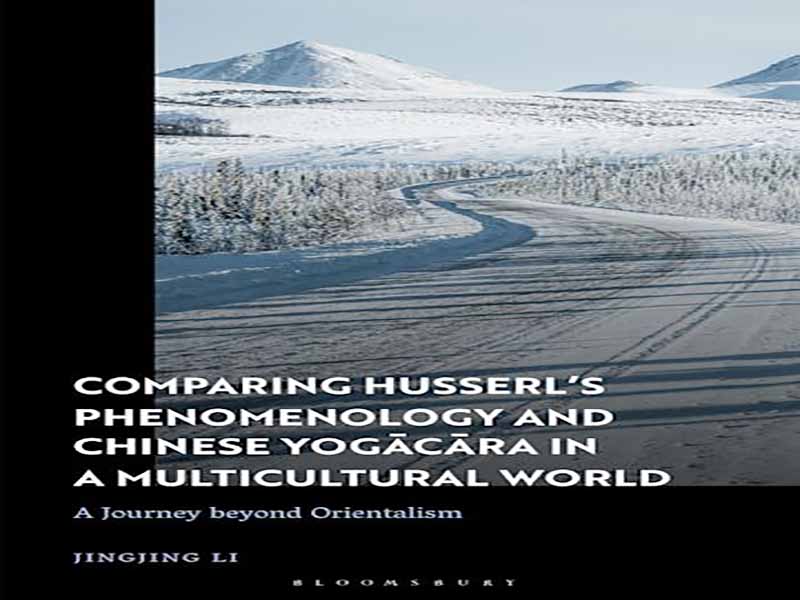- عنوان: Comparing Husserl’s Phenomenology and Chinese Yogacara in a Multicultural World / A Journey beyond Orientalism
- نویسنده: Jingjing-Li
- حوزه: شرق شناسی
- سال انتشار: 2022
- تعداد صفحه: 266
- زبان اصلی: انگلیسی
- نوع فایل: pdf
- حجم فایل: 1.79 مگابایت
فیلسوف بودایی N ā g ā rjuna (حدود 150-250) زمانی از حریف خود به عنوان کسی یاد کرد که سوار بر اسب می شود اما اسب را فراموش می کند (T30N1564, P33a26-7). اسب در اینجا استعاره ای از روش شناسی است. N ā g ā rjuna با یادآوری اینکه چگونه اشتباهات آنها را در مقدمه استدلال آنها می توان یافت، به مخاطبین خود یادآوری می کند که خطر نادیده گرفتن پیامدهای اساسی در رویکرد ما به مطالعه فلسفی ایده ها را برای ما آشکار می کند. با در نظر گرفتن این هشدار، ما مستقیماً به مطالعه تطبیقی پدیدارشناسی هوسرل و یوگ چینی در پروژه خود نخواهیم پرداخت. در عوض، ابتدا باید بپرسیم که وقتی مقایسه ای در میان یک شکاف فرهنگی، تاریخی و زبانی به همان اندازه اصلی انجام می شود، چه چیزی دخیل است. به این ترتیب، با بررسی رویکرد خودمان به مطالعات تطبیقی و توضیح روششناسیهایمان، میتوانیم هنگام شروع سفرمان، مراقب اسبی باشیم که سوار آن هستیم. پس از دههها توسعه، فلسفه تطبیقی با نقدها و چالشهای متعددی روبرو بوده است که بخش کوچکی از آن به دلیل تاریخ درهمتنیده این رشته با شرقشناسی است. شرقشناسی بهعنوان گفتمانی که از زمان استعمار رایج شد، مظهر شیوهای از تفکر است که جهان را بیش از حد به شرق و غرب تعمیم میدهد. اگر فلسفه تطبیقی بتواند روشی را برای مردم فراهم کند که فراتر از دوشاخه شرق شناسی بروند، آنگاه این پتانسیل را حفظ می کند که راه هایی را که در عصر جهانی شدن در گفتگوهای بین فرهنگی درگیر می شویم، به نمایش بگذارد. و بنابراین، در برابر این پسزمینه، امیدواریم سه سؤال را پیشزمینه کنیم. اول، چگونه فلسفه تطبیقی می تواند چندفرهنگی را بدون تداوم شرق شناسی و امپریالیسم فرهنگی مرتبط با آن ترویج کند؟ دوم، چرا با توجه به تحولات اخیر در این زمینه، به اتخاذ رویکرد مقایسه ای در این کتاب ادامه می دهیم؟ و در نهایت، وقتی از پروژه خود به عنوان “فلسفه تطبیقی” یاد می کنیم، منظور ما چیست؟ برای یادآوری اسبی که برای سفر خود سوار میشویم، بخش اول این کتاب به بررسی روشهای ما اختصاص دارد. پس از بررسی دقیق این که چگونه رویکردهای به کار رفته توسط فیلسوفان تطبیقی زمانی با نسخههای مختلف شرقشناسی آغشته شدهاند، رویکرد «هم-و» را پیشنهاد میکنم که از تلقی سنتهای فکری بهعنوان انحصاری متقابل خودداری میکند و به عدم دوگانگی همبستگی این سنتها پی میبرد. به طور دقیق تر، این رویکرد هم تمایز هر سنت را در زمینه خاص خود برای کاوش در حد وسط آن حفظ می کند و هم پیوند آنها را در فضای مشترک معنایی گسترده تر برای گفتگوها و همکاری ها آشکار می کند. هدف از این رویکرد سه چیز است: اول، جلوگیری از ادغام سنت ها در نهاد سوم. دوم، پرهیز از تلقی این سنت ها به عنوان متضادهای قطبی. و سوم، برای گسترش افق مشترک خود. منابع الهامبخش اصطلاح «هم – و هم» از سنتهای پدیدارشناسی و نیز بودایی آمده است. هانس گئورگ گادامر گسترش افق مشترک را از طریق قیاس مسافر تصور می کند، که در آن مسافری با ظرفیت ورود به واقعیت های زیسته متفاوت «هم اینجا و هم آنجا» باقی می ماند (گادامر 1989: 458). در اصطلاح بودایی، “هم-و” ایده مسیر میانی را در تاکید آن بر کاهش ناپذیری و وابستگی متقابل باینری ها در بر می گیرد (T30N1564، P33b11-12). بحث روششناسی را در فصل 1 بیشتر خواهیم کرد. در فصلهای 2 و 3، پدیدارشناسی هوسرل و یوگ چینی را در زمینههای مربوطه قرار میدهیم. برای گفتوگوهای بینفرهنگی، زمینهای بودن از این جهت مهم است که ایدهها – اگرچه همیشه تولید نمیشوند – توسط فضای اجتماعی-سیاسی بزرگتری که در آن شکل گرفتهاند، پرورش مییابند. در زمینهسازی پدیدارشناسی و یوگآرا، از ترکیب و کنار هم قرار دادن فاصله میگیریم تا به کثرتی از واقعیتهای زیسته متفاوت از واقعیتهای خود وارد شویم. با سفر بین این واقعیتها، راه میانهای را برای سفر خود فراهم خواهیم کرد. زمانی که ما چارچوب را برای مقایسه معرفی می کنیم، حد وسط رخ می دهد. این یک چارچوب سه سطحی است – سه سطح توصیفی، توضیحی، و تجویزی – که میتوان از آن استنباط کرد و بنابراین هم در مورد پدیدارشناسی هوسرل و هم در فلسفه یوگ آ سی آرا بیان شده توسط ژوانزانگ و شاگردانش به کار رفت. این دو سنت به دور از اینکه متقابلاً منحصر به یکدیگر باشند، می توانند در سطوح مختلف وارد گفتگوهای سازنده شوند. بنابراین برای افرادی که از این سنتها آمدهاند ممکن است در دنیای چندفرهنگی با یکدیگر همکاری کنند.
Th e Buddhist philosopher N ā g ā rjuna ( c. 150–250) once referred to his opponent as the one who rides on horseback but forgets about the horse (T30N1564, P33a26–7). Th e horse here is a metaphor for methodology. Reminding his interlocutors how their mistakes can be found in the premise of their argumentation, N ā g ā rjuna likewise reveals to us the danger of overlooking the underlying implications in our approach to the philosophical study of ideas. Bearing in mind this warning, we will not jump directly into a comparative study of Husserl’s phenomenology and Chinese Yog ā c ā ra in our project. Rather, we must fi rst ask what is involved when a comparison is made across a cultural, historical, and linguistic divide as major as this one. As such, by examining our own approach to comparative studies and explicating our methodologies, we can remain mindful of the horse we are on when we begin our journey. Aft er decades of development, comparative philosophy has faced several critiques and challenges, in no small part owing to the fi eld’s tangled history with Orientalism. As a discourse popularized since the time of colonization, Orientalism epitomizes a way of thinking that overgeneralizes the world into the East and the West. If comparative philosophy can furnish people with a method to go beyond the Orientalist bifurcation, it then retains the potential to showcase the ways in which we engage in intercultural dialogues in the era of globalization. And so, against this backdrop, we hope to foreground three questions. First, how can comparative philosophy promote multiculturalism without perpetuating Orientalism and its related cultural imperialism? Second, why are we continuing to adopt the comparative approach in this book given the recent developments in the fi eld? And lastly, what do we mean when we refer to our project as “comparative philosophy”? To remind us of the horse we are riding for our journey, the fi rst part of this book is dedicated to examining our methodologies. Aft er scrutinizing how the approaches employed by comparative philosophers were once imbued with diff erent versions of Orientalism, I propose the “both–and” approach that refuses to treat intellectual traditions as being mutually exclusive and realizes the correlative non-duality of these traditions. To be more specifi c, this approach will both maintain the distinctiveness of each tradition in its own context for exploring their middle ground and manifest their interconnectedness in the broader shared space of meaning for conversations and collaborations. Th e purpose of this approach is threefold: fi rst, to avoid assimilating traditions into a third entity; second, to refrain from treating these traditions as polar opposites; and third, to expand their shared horizon. Sources of inspiration for the term “both–and” come from the phenomenological as well as the Buddhist traditions. Hans-Georg Gadamer envisions the expansion of the shared horizon through the traveler analogy, in which a traveler with the capacity of entering diff erent lived realities remains “ both here and there ” (Gadamer 1989: 458). In Buddhist terms, “both–and” encapsulates the idea of the middle path in its stress on the irreducibility and interdependence of binaries (T30N1564, P33b11–12). We will further the discussion of methodology in Chapter 1. In Chapters 2 and 3, we position Husserl’s phenomenology and Chinese Yog ā c ā ra in their respective contexts. For intercultural dialogues, contextuality is important in that ideas are cultivated—though not always produced—by the greater sociopolitical climate in which they came to be. In contextualizing phenomenology and Yog ā c ā ra, we distance ourselves from synthetization and juxtaposition to enter a plurality of lived realities diff erent from our own. Traveling between these realities, we will secure a middle ground for our journey. Th is middle ground transpires when we introduce the framework for comparison. It is a three-level framework—the three levels being the descriptive, the explicative, and the prescriptive—which can be inferred from and therefore applied to both Husserl’s phenomenology and the Yog ā c ā ra philosophy articulated by Xuanzang and his disciples. Far from being mutually exclusive to one another, these two traditions can be brought into constructive conversations on multiple levels. It is therefore possible for people coming from these traditions to collaborate with one another in a multicultural world.
این کتاب را میتوانید از لینک زیر بصورت رایگان دانلود کنید:
Download: Comparing Husserl’s Phenomenology and Chinese Yogacara in a Multicultural World



































نظرات کاربران